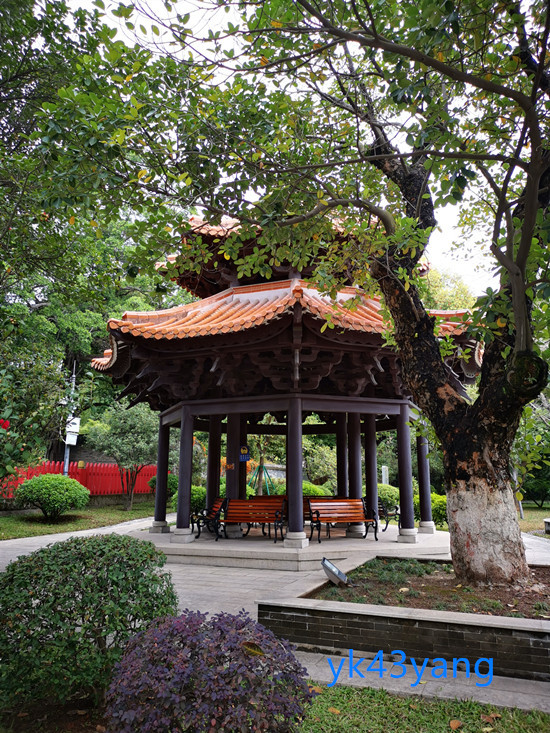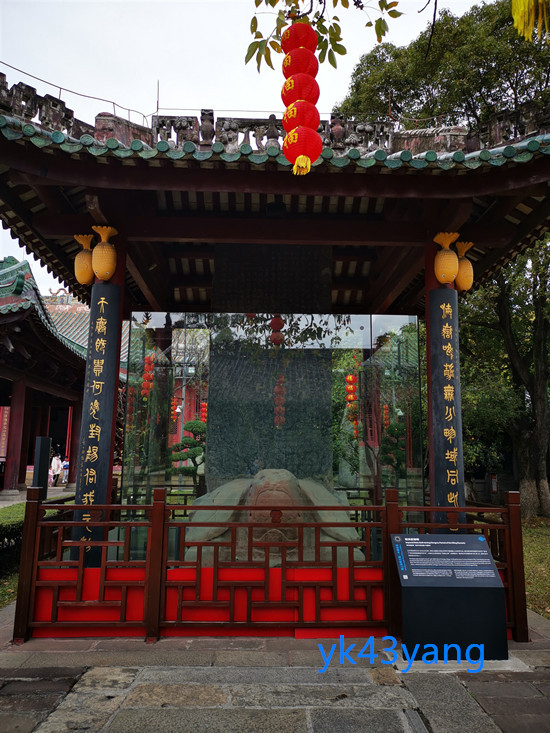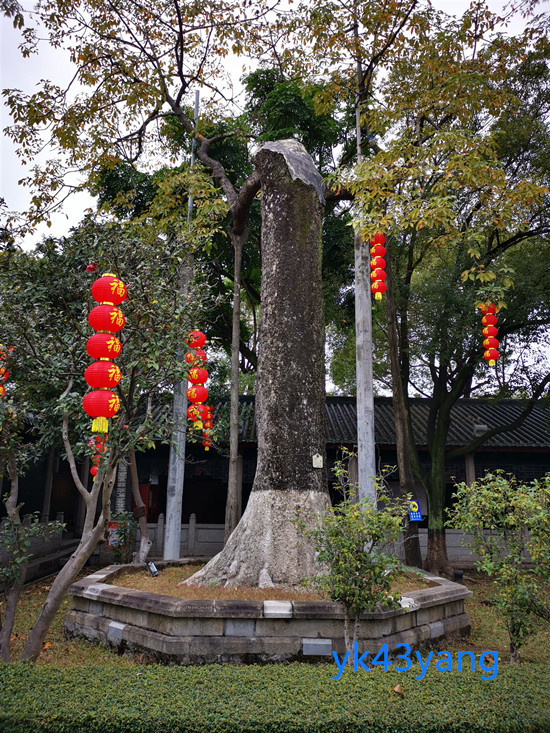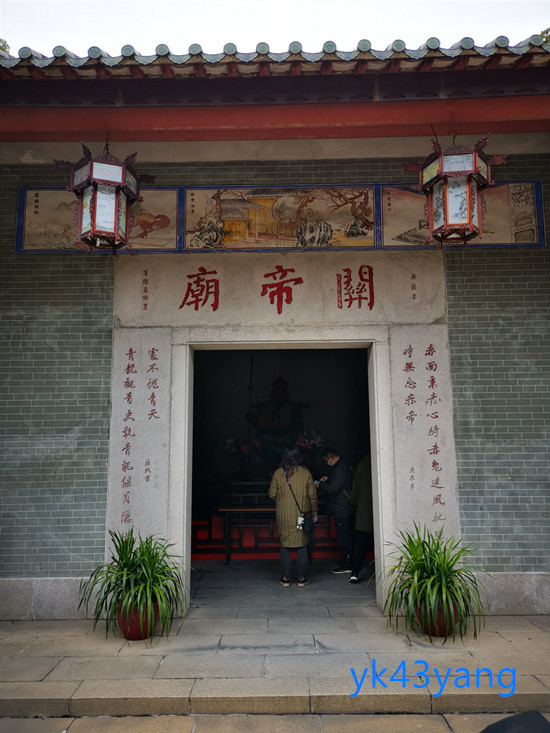Travel Notes on Nanhai Temple in Guangzhou during the Spring Festival of 2022
North of the archway is like an ancient river channel. Across the bank to the north is the South Square. There are many ancient banyan trees on the south square, with luxuriant branches and leaves. I wonder how old they are.

At the north end of the square is the "Sea Buyang Waves" stone tablet square. When the temple was built in the Sui Dynasty, it was originally a wooden stele workshop. The stone tablet workshop was not built until the Ming Dynasty. What we see now is built in the 28th year of Daoguang.

The "Sea Buyang Waves" stele workshop is the symbol of the Nanhai Temple. It is said that there are more than 30 archways in the Pearl River Delta and Hong Kong and Macao, and this one here is the authentic one.
After the archway is the gate of the temple-called the "head gate" here. Toumen is a relic of the Qing Dynasty and still retains the Qing Dynasty style after being rebuilt in modern times. The head gate is a hard mountain top, with three rooms wide and eight-shaped walls on the east and west. This is a symbol of high standards.

There are left and right front school platforms and left and right rear school platforms respectively before and after the gate. This is the architectural style of the Zhou Dynasty. The two statues of Shunfenger and Clairvoyance are painted on the east and west front schools respectively. It can be seen that in sailing, mastering information is the most important thing.


In front of the head door, there is a stone carving watch on the left and right. The dragon clouds circled extremely exquisite. Huabiao is a symbol of ancient kings encouraging people to speak up.

A pair of red sand stone lions in front of the door are relics of the Ming Dynasty. To prevent damage, it was covered with a glass cover.

There is a plaque on the head door with the inscription "Nanhai Temple". There are couplets hanging on both sides, which read: "When the white waves rise, the waves beat the sky, the mountains break, and the thunder and wind breathe; after the black clouds leave, the clouds sprout blowing across the river, the sea blooms, and the moon and moon are breathing."

The original couplet was written by Lin Zijue, Zengcheng in the Qing Dynasty. The current couplet was supplemented by Lu Youguang, a famous calligrapher in Guangdong Province, in 1991.
On the two gates, two door gods are painted respectively, probably Qin Qiong and Yuchi Gong.


Entering the head door, you can see the inner school platforms on both sides.

There is a stele pavilion on the left and right sides of the head door. On the east side is the Tang Stele Pavilion, and on the west side is the Kaibao Pavilion.

Inside the Tang Stele Pavilion is the "Nanhai God Guangli King Temple Monument" erected when the Nanhai Temple was rebuilt in the 15th year of Yuanhe of Emperor Xianzong of the Tang Dynasty (820 AD). Han Yu, the governor of Yuanzhou, wrote an article, Chen Jian, the governor of Zhouzhou, wrote an article, and Li Qi, a famous carver, carved the stele. All three were famous artists of the time, so it was called the "Sanjue Stele" in history. This Tang stele is the temple treasure of Nanhai Temple. The inscription records the origin and development of the Nanhai Temple, the custom of worshipping the sea goddess in the Tang Dynasty, as well as the maritime trade at that time. It is said that the word "maritime" first appeared in this inscription.
There are couplets hanging on the pillars of the Tang Stele Pavilion:
"I wish the book to pass through the city, and when I enter the hall, I will cherish the people of Confucius in the spring breeze; the article carries the message, and I will go to the door to recognize the Korean Monument"
The list of blessings in the article is from the 13th year of Yuan He, who was ordered to come to sacrifice to officials in the temple. Since then, the major repair of the temple began.
What was erected in the Kaibao Stele Pavilion is the "Stele of King Guangli Newly Built in the Song Dynasty" erected in the sixth year of Kaibao by Taizu of the Song Dynasty. The inscription says that after the Song Dynasty overcame the Southern Han Dynasty and recovered Lingnan, it first established a Shibo Division in Guangzhou to manage foreign trade and was appointed as an envoy to repair the temple. Pan Mei, the founding Marquis, was also granted the title of the first city ship envoy in the Song Dynasty. This stele is the second stele to hold treasures in the Nanhai Temple.

There is also an Imperial Stele Pavilion in front of the left of the Tang Stele Pavilion. This is an octagonal pavilion with double eaves. The Kangxi Imperial Monument in the Imperial Monument Pavilion has now been moved to the Qing Monument Pavilion behind the Yimen.

The front of the courtyard is the second door-the instrument door.
The instrument gate stands on the base of the platform, and walk up to the front of the instrument gate from a row of steps in the middle.


A horizontal plaque is hung above the ceremonial door with the inscription "" Holy Virtue ", and there are couplets on both sides: " The god of Zhenhai is immortal; the Sinan Temple is majestic.“


There are multiple corridors on both sides of the instrument door. On the east side of the outer side of the complex corridor, a statue of Daxi Sikong is dedicated. Sikong Dashi, known by local people as "Fan Ghost Wangpolo", is the history of Indian tribute introduced above. The statue's left hand is topped, as if looking at the sea. There are couplets on both sides of the shrine, depicting his longing for home:
"When sailing from the South China Sea, I have deep feelings for Paramita; when the white clouds are relaxed, my country is worried about Majiaduo.“

On the east side of the complex corridor, there is also a golden flower goddess.

It is said that Emperor Jiajing of the Ming Dynasty once successfully prayed for children from the Nanhai God. Later, it became a folk custom to go to the Nanhai Temple to pray for children. The steps to pray for God are to first pay homage to the Nanhai God, then go to Zhaoling Palace to pay homage to the Nanhai God's Lady, and finally come to kneel down in front of the Jinhua Goddess and take away the child puppet placed next to the Jinhua Goddess. This is also a bit like a "tied baby" in the north.
To the west of the outer compound corridor is Guanyin Hall, and the shrine is dedicated to Guanyin Bodhisattva... Guanyin Hall also has couplets with the inscription:
"Guanyin colored the western moon; listening to and seeing the silent South China Sea tide."
Nanhai Temple is a Taoist temple. It seems strange that a Buddhist Bodhisattva is enshrined here. However, this is the golden mean of Chinese religion. If the benevolent and merciful Guanyin Bodhisattva also participates in the protection of navigation, the safety will of course be even higher!
There are stele corridors on both sides of the inner complex corridor, where many famous steles are stored. These include:
Li Yubei's "Baoqing Rebuilding Monument" in the first year of Baoqing in the Song Dynasty. The inscription records the historical fact that the Song Dynasty granted the sea god the title of "Hongsheng Guangli, Zhaoshun and Weixian King" in successive dynasties. It also explains that the money for building the temple came directly from Haihe trade rather than from the government.
The "Nanhai Guangli Hongsheng Shengzhao Shengwei Xian Wang" stands in the first year of Qiandao in the Northern Song Dynasty. The inscription records the process of the Tang and Song dynasties emperors sealing the sea god. It also depicts the heyday of Guangzhou's foreign trade development in the Song Dynasty.
"The Story of the Nanhai Temple" dated from the fifteenth year of the Zhizheng Dynasty of the Yuan Dynasty. The inscription records how the Yuan Dynasty emperor personally distributed incense and candles to various envoys in the Ming Hall on the first day of the New Year, and then went to various places to worship Yuezhen Haidu. Among them, the envoys who went to the South China Sea came here to offer sacrifices after four months of running.


Because the glass cover reflects light, it is impossible to take photos. So I photographed these non-reflective pieces:
This one is: "Rebuilding Nanhai Temple Monument" in the fourth year of Yeping in the Song Dynasty

This one is: "The Rebuilding of Nanhai Temple" in the 8th Year of Chenghua in the Ming Dynasty

This is the monument of the "Sacrifice to the King of Nanhai" in the 15th year of the Yuan Zhizheng Dynasty

This is the "Monument of the Six Marquises of the Song Dynasty"

There are still many stele inscriptions that I can't take a closer look at them one by one.
From the porch to the courtyard of the main hall.

The front of the courtyard is a main hall, and there is a ceremony pavilion in front of the main hall-equivalent to the worship pavilion in other temples.

The Li Pavilion is an antique building on the top of Xie Mountain, with couplets hanging on the front pillar of the pavilion:
Huangmuwan thinks back to the past, when the clouds and rocks of the vast sea and the sea were strong, and the stars were moving. I wonder where Hong Sheng and Wei Ling are today?
Looking at this occasion under the red cotton flames, I wander and rest in my shadow, touch the broken stele, and pursue the folk customs of the country forever!
There is a bronze drum of the Eastern Han Dynasty placed in the ceremony pavilion. According to reports, this bronze drum was unearthed in Gaozhou and is the third largest bronze drum in China. The drum body has delicate patterns, and six lively and lovely frogs are cast around the drum surface, which shows the exquisite craftsmanship at that time. However, to be honest, judging from its old and new quality, I doubt that this is an authentic piece.

There is a stele pavilion on the left and right in front of the ceremony pavilion.

In the stele pavilion in the west stands the imperial stele of Emperor Kangxi. In the twenty-second year of Kangxi, the Qing army invaded Taiwan. In the twenty-third year of Kangxi, the sea ban was opened. The 42nd year of Kangxi was the emperor's 50th birthday. Fan Chenglie, assistant minister of the Ministry of Revenue, was appointed here to sacrifice to the Nanhai God. At the same time, he brought the four characters "Thousands of Miles of Waves" from the emperor's royal book. However, the imperial tablet we see now is obviously a replica. The original monument was destroyed during ten years of unrest.
The neutral part of the stele pavilion in the east is the emperor's imperial stele erected in the third year of Hongwu of the Ming Dynasty. What is written on the monument is: "The five mountains and the four seas are for mountains and rivers. Their gods must be ordered by God. Non-national titles can add glory. Therefore, the titles of previous generations will be cancelled and the gods of mountains and rivers will be honored with their original names."
Zhu Yuanzhang is worthy of being a monk. Compared with scholars, he knows better about the laws and regulations in the immortal world.

There are couplets on the pillars of the stele pavilion:
"The sea and mountains are only peaceful, and there is no boundary zone with them. Since the heaven is noble, how can we rely on the seal of Yang to protect us?"
The red gravel under the Hongwu Imperial Monument is extremely huge and seems to be an old object.
In front of the two stele pavilions, there is an ancient kapok tree, which is about 300 years old. It is known as the No. 1 and No. 2 trees in Guangzhou. It is a major wonder in the temple. Whenever a pineapple is born, the trees are full of red flowers, which is very spectacular. Qu Dajun once wrote the "Ancient Kapok Song of the Nanhai Shrine":
"The ten zhang coral is kapok, and the flowers bloom are brighter than the morning glow.
The trees in the south of the sky are as big as Panzhihua.
The towering ancient trunks compete for the plate, but when flowers are blooming, there are no leaves, why flowers are blooming!
Butterfly cocoons decorated with white branches and braised hibiscus sand."

When we came, it was not in bloom. So I didn't see kapok blooming. I remember the last time I came here, the flowering period had ended. The ground is full of red flowers, but they are invincible. Many tourists are picking up fallen flowers. According to the customs of Guangzhou people, kapok can be used to make soup by drying and washing it.
The kapok blooms first and then leaves. The flowers are as red as fire and are the city flowers in Guangzhou, Meizhou and other places. We saw such a huge ancient kapok tree. Although it did not bloom, it was already a blessing for our eyes.
In front of the main hall, there is also a pineapple tree. There must be pineapples in the pineapple temple. They were newly planted during the renovation in the 1980s. Whenever the trees are full of jackfruit, it is also a major sight of the temple.
The main hall of the temple is five rooms with a wide face and resting on the top of the mountain. There is a couplet hanging on the front pillar:
"The temple began to open to the emperor, and the sea silk was far away. The Red Emperor's name hangs in the new century;
The Tang Dynasty granted Guangli and always maintained Lingnan cultural relics. Cui Hua Ling is written in ancient Panyu.“
In the center of the hall is the god of the South China Sea.

Nanhai God is the god of the south-Zhurong. Zhurong is the legendary Fire God. It is really a strange thing to be both Fire God and Sea God who are incompatible with water and fire.
Statues of the six marquises stand on both sides of the hall. The six marquises were the six assistants of the Nanhai God. They were: Sikong Daxi, Marquis of Suli, Sikong Du Gong, Marquis of Suhui, General Cao, Marquis of Jiying, Marquis of Shixun, Marquis of Suyin, Prince Ichirang, and Prince Erlang, Marquis of Zanning.
It is said that under the seat of the southern god is the "dragon cave" of the temple. The soil below is moist all year round. However, since he is under the throne of God, there is no verification.
Under the west wall of the hall, there is also an iron bell from the Ming Dynasty. This bell weighs more than 300 kilograms and was cast in the sixth year of Daizong Jingtai. At that time, the Ming army led by Yu Qian repelled the invasion of the Wara people. So this big bell was cast and given to the temple to show that the world was at peace. Speaking of this Yu Qian, his achievements were unmatched, but his end was very tragic. He was executed by Emperor Yingzong, who returned to power after the "Mutiny of Seizing the Gate".
Behind the main hall is Zhaoling Palace. This is the harem of the Nanhai God. What is offered in the hall is the Goddess of the Sea God.

Couplets are also hung on the front porch pillars of Zhaoling Palace:
"Assisting Zhu Chi to protect Yanzhou, and worships Kunde Gong; participating in supporting Xu 'er' an in the Hall, with a solemn ceremony.“
There are also couplets on both sides of the gate:
"Mingdesi stayed in the Guangdong Sea with sincerity; he worshipped people in accordance with the times and admired Kunyi.“
The harem was in disrepair for a long time. During the Republic of China, Chen Jitang's wife Mo Xiuying funded the maintenance of the Nanhai Temple. Due to insufficient funds, the harem was converted to a cement brick column structure. When it was rebuilt in 1986, it retained its original appearance when it was rebuilt during the Republic of China.
The goddess of Nanhai is enshrined in the palace, with a dignified appearance and a peaceful expression. Song Renzong was granted the title of Lady Mingshun.
Behind the harem, there is also an ancient kapok tree. The age of the tree is slightly lower, but compared to other places, it is still an ancient tree.
Go back to the front yard from the west side of the main hall, where there is another Guandi Temple on the west side. There is a temple within a temple, which is a spectacle. Guandi Temple is newly built. The three words "Guandi Temple" on the forehead of the door are the words Ji Yan Zhenqing. The couplet on both sides is titled,"Red face and red heart, riding a red rabbit to chase the wind, never forgetting the Red Emperor while driving; green dragon observes Qing history, holding green dragon crescent moon, and the hidden place is worthy of the blue sky." The signature was Su Shi.

Out of the west gate of the temple, the stone lion outside the door is a precious cultural relic.


This pair of stone lions was made by Geng Jingzhong, King of Jingnan at that time, using white stones from Qixingyan. It was a gratifying gift to King of Pingnan. This pair of stone lions has been placed in front of the gate of Pingnan Mansion. During the Republic of China, Chen Jitang ruled Guangdong. The Guangdong Provincial Government was built on the former site of Pingnan Palace. This pair of stone lions has been standing in front of the gate of the provincial government. It was moved to Nanhai Temple after liberation.
Outside the West Gate, there is also the Guangdong Folk Culture Park. Some models of Guangdong folk buildings are made in the park. In addition, there is also a Suzaku Terrace. The so-called North Xuanwu and South Vermillion Bird are also feng shui. However, the sculpture on the stage was not a Vermilion Bird, but five "pineapple chickens".


Pineapple chicken is a folk handicraft made of clay paper and chicken feathers. Legend has it that in ancient times, an old woman named Zhang lived near Boluo Temple and kept a big cock. Later, the rooster was stolen and slaughtered by the landlord in the village. The sad old woman picked up the chicken feathers one by one and made a fake chicken out of yellow mud and paper skin.
Strangely enough, the fake chicken can crow in the morning again. So the old lady made many chickens and sold them at the temple fair. It is said that "pineapple chicken" can bless the happiness of the whole family. The custom of buying Boluo chickens at Boluo's birthday was passed down.
I have never believed such legends. That pineapple chicken can't even protect its own life. How can it keep you safe?
Further west, there is a small earthen hill named "Zhangqiu". There were many stone figures and stone horses standing under the stage, I don't know where they had been relocated. There is a row of steps to work on the job, and there is a "bathing pavilion" on the top of the post. When I came this time, the steps up the mountain had been closed and no tourists were allowed to climb the mountain. The last time I came here, I could go all the way up the mountain.


Daybathing pavilions existed in the Tang Dynasty. At that time, Zhangqiu was surrounded by water on three sides, and you could watch the sunrise on the sea by standing in the sunbathing pavilion. Among the eight scenic spots in Yangcheng rated during the Song and Yuan Dynasties, the "Fuxu Bath Day" here ranked first.
In the early years of Shaosheng of Song Zhe (1094 AD), Su Dongpo was demoted to Huizhou, passing through Nanhai Temple, and staying at Haiguang Temple. Early the next morning, climb to the bathing pavilion and watch the sunrise. Immediately wrote this seven laws:
The sword qi shines through the sky at night, and the auspicious light will arrive in Nanwan tomorrow.
Sit and watch the floating gold halo in Yanggu, and think of the surging snowy mountains in Qiantang.
I have already felt desolate and sick, and I am even more annoyed to wash my fading face.
Suddenly, the startled bird stirred up the pedestrians and flew up among the purple and green mountains of the thousand peaks.
In the present pavilion, there is the "Su Dongpo Poetry Monument".
There are red bean trees under Zhanggang. Because of Wang Wei's red bean poem: "Red beans grow in the south, how many branches will they produce in spring? May you pick more, this is the most lovesick." Red beans have become "lovesickness beans". Every year during Polo's Birthday, many young people come here to pick up lovesickness beans and give them to their lovers.
In this way, the tour of the Sea God Temple was ended. I took the subway back to Nangang and had lunch at the Hunan cuisine restaurant there. The day's sightseeing ended here.

Previous Article:[Spring Tour Season] Flowers bloom in Guangzhou and bloom in the sun| Travel Notes on Super Travel Destination Guangzhou
Next Article:Have you ever tried going to a cave to soak in a hot spring?
